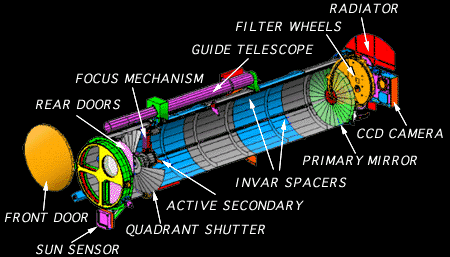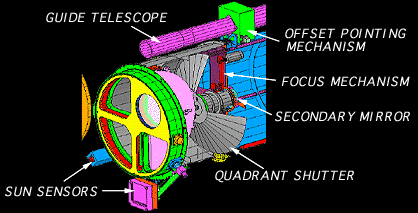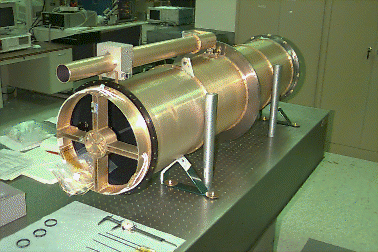
![]()
![]()
|
|
|
|
| Front End | Focal Plane | Photo |
Cut-Away View

 |
| |||||||||||
|
|
| Front End | Focal Plane | Photo | Cut-Away View  |
|
|
The 30 cm aperture TRACE telescope uses four normal-incidence coatings for the EUV and UV on quadrants of the primary and secondary mirrors. The segmented coatings on solid mirrors form identically sized and perfectly coaligned images. Pointing is internally stabilized to 0.1 arc second against spacecraft jitter. A 1024 x 1024 CCD detector collects images over an 8.5 x 8.5 arc minute field-of-view (FOV). A powerful data handling computer enables very flexible use of the CCD array including adaptive target selection, data compression, and fast operation for a limited FOV. |
|
|
|
|
|
 |
|
|
The four mirror quadrants are selected by the quadrant selector behind the instrument entrance window. |
|
|
|
|
|
Telescope Housing and Guide Telescope  Extensive
heritage enables the TRACE team to create
an instrument more capable than might be expected on a SMEX
budget. The NIXT rocket payload
has taken the highest resolution EUV coronal images ever,
and the NIXT team will provide the mirrors for TRACE. The
SXT instrument has produced more than two million soft X-ray
images of breathtaking quality. To manage, process, and
analyze the SXT data, we have produced a very complete set
of well documented image cataloging, archiving, and analysis
software which will be used for the TRACE investigation. The
MDI program has produced a complete flight instrument for
SoHO including a CCD camera, image stabilization system,
control and data handling computers , software, and highly
reliable mechanisms. Many of the MDI designs and some of the
spare flight hardware will be used on TRACE. The personnel
(scientific, engineering, and management) and facilities
assembled for SXT and MDI are ready to begin. These factors
permit us to build a sophisticated instrument within the
cost and time constraints of the Small Explorer program. Our
operational experience and software base developed from the
La Palma SOUP observations and the SXT and MDI missions will
enable us quickly and efficiently to generate scientifically
important and visually exciting results. |
|
|
|
|
|
|
|
|
|
|
|
|

|
|
|
|
Solar and Astrophysics Labs) |
|
|
email: hurlburt@lmsal.com
|
|